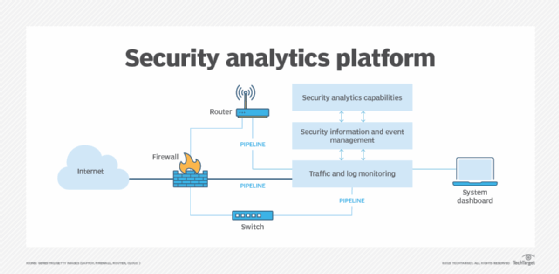IT security professionals use a variety of tools to gather timely, actionable information about threat actors so they can proactively respond to the increasing variety and frequency of cyberattacks.
One of the key tools that help security teams handle this task is a security analytics platform. Let’s explore these tools, why they matter, what they do, how they’re evaluated, and a list of products to consider.
What is a security analytics platform?
Basic cybersecurity threat analysis uses system log analyzers and network traffic monitoring tools that use pipelines to connect to network elements. These technologies examine network traffic passing through an access device, collect traffic data, and compare that traffic data to rules and other parameters stored in the system. When suspicious data packets are identified, the tool flags anomalies via alarms and system dashboard messages.
The next level of cybersecurity analytics is SIEM. SIEMs use powerful algorithms and other tools to provide additional assessment of suspicious traffic. SIEM systems provide recommendations based on pre-programmed messages presented in traffic analysis.
The best cybersecurity threat assessment tools are security analytics platforms. Using advanced programming with AI and machine learning, security analytics tools perform further functions such as User Entity and Behavior Analysis (UEBA) to give security analysts insight into threat origins and threat behavior, and threat provides greater insight into what to do next. The security analytics platform also provides recommendations based on behavioral analysis, such as preventive actions to reduce the attack surface and how to reduce the severity of events in the event of an attack.

Cybersecurity analysis tools can connect to almost any network device. In Figure 1 they are connected to firewalls, routers, and network switches. These tools can be programmed to monitor traffic and identify and flag anomalies based on an internal database of threat vectors. A SIEM system can be layered on top of the base system when more data and incident management processes are needed.
Security analytics platforms can be added as the frequency and severity of attacks increase. Security analytics tools gather information from her two other levels and use AI to perform more advanced analytics to examine the data and generate more detailed insights and recommendations.
Many products on the market today offer a combination of three levels of security analysis.
Why security analysis tools matter
Cybersecurity management is an ongoing cat-and-mouse game. Security software developers are constantly working to identify new threat actors and malicious code and develop mitigations and remediations for them. At the same time, attackers are constantly developing new malware techniques and malicious code to bypass firewalls and other network defenses and damage internal networks, systems, and data.
Protecting your personally identifiable and personal health information, as well as your valuable business-critical corporate data, is critical. Investing in a powerful cybersecurity analytics platform is one of the most important budget items for IT departments in 2023 and beyond. The cost of security analysis tools may be prohibitive for small businesses, but large IT departments today cannot exist without them.
Security analytics platform application
Security analytics tools are built to prevent cyberattacks. Dig deeper into your network security data with a purpose-built AI-powered analytics engine. One of the main features of the tool is motion analysis. It examines event data in various contexts looking for:
- A particular pattern of how the attacks were prosecuted.
- Which resource was attacked and how.When
- Post-event trails exist that can provide additional insight into the perpetrators.
Security analytics platforms use AI to remediate vulnerable devices and systems and also provide recommendations to prevent future attacks.
Other activities that can be performed with a security analytics platform include:
- Vulnerability scanning and assessment
- Penetration testing and threat hunting
- Cyber incident response activities
- Compliance evaluation
- Endpoint detection and response
How to choose an effective security analytics platform
Most established organizations use cybersecurity prevention, detection, and mitigation techniques. Organizations using basic security analysis tools are encouraged to upgrade to more powerful options based on the number and severity of cyberattacks they face.
Look for a platform that starts at a basic level and allows you to add more powerful modules. Switching vendors may require a learning curve to master speed. As with any IT investment, follow these steps:
- judge the situation. For example, you need to upgrade your existing system.
- Advise management on the need for cybersecurity analysis tools. Secure management approval and funding.
- Research the market and vendors for available products and services. Decide on a deployment model (on-premises, cloud-based, or managed service).
- Start your free trial.
- Identify prospective candidates with cross-product flexibility, standards compliance, and ability to integrate into existing infrastructure.
- Explore pricing options. Note that most products have flexible pricing based on the number of gigabytes of data analyzed per month. Some products have a backend usage and maintenance cost in addition to the initial cost.
- Examine the capabilities of candidate systems based on current and anticipated needs.
- Determine the learning curve employees may face with the new vendor’s system. Ask your vendor if training is available.
- Examine the amount of data and reports displayed on the candidate’s dashboard.
- Consider the level of analysis performed by the product, the types of reports generated, and additional value-added deliverables.
- Determine the extent to which a system (particularly a cloud-based system) allows for user interaction.
- Explore additional services the vendor offers, such as vulnerability and penetration testing, incident response support, and cybersecurity planning assistance.
- Explore our services for testing and validating compliance with cybersecurity standards.
- Utilize the system development lifecycle during the planning and implementation stages.
- Review the training and documentation provided along with support for system implementation and acceptance testing.
10 security analytics platforms to consider
Organizations that want to maximize their event detection and remediation capabilities to address the widest range of potential cyberattacks can benefit from security analytics tools. Many tools combine log management and her SIEM capabilities into one security platform, while others offer add-on security analytics capabilities.
Security analytics tools offer powerful analysis and reporting capabilities, but they come at a price. With the right tools, you can gain greater visibility into your network operations and track false alarms to minimize wasted time.
Below are 10 cybersecurity tools and platforms that provide security analytics capabilities. Please contact the vendor for pricing.
- Splunk Enterprise Security A SIEM platform with many advanced features. Offered as a value add to Splunk Cloud Platform and Splunk Enterprise.
- Pros: Powerful system. Many features and dashboards.
- Cons: Learning curve.
- SolarWinds Security Event Manager SIEM software.
- Pros: Efficient data collection. dashboard; compliance reporting;
- Cons: Learning curve.
- IBM Security Guardium is a data protection platform designed for large-scale enterprise network requirements.
- Pros: Security analysis capabilities. dashboards; compliance features;
- Cons: Learning curve.
- Logrhythm SIEM A SIEM platform that provides a security analytics layer.
- Pros: Advanced security analytics capabilities. Dashboard.
- Cons: Learning curve. upgrade process.
- Securonix Next-Generation SIEM It has advanced features such as security analytics capabilities.
- Pros: Support for security analysis. dashboard; reporting.
- Cons: Not specified.
- exabeam fusion A SIEM platform with advanced features like security analytics.
- Pros: Security analysis capabilities. Available for onsite and cloud-based installations.
- Cons: Not specified.
- Microsoft Azure Advanced Threat Protection (ATP) An enterprise-grade on-premises and cloud platform with advanced security analytics that replaces Advanced Threat Analytics and provides end-to-end security anomaly investigation and analysis.
- Pros: Security analysis capabilities. enterprise applications; on-premises and cloud deployments; Address endpoint issues by linking with Windows Defender ATP.
- Cons: Learning curve. upgrade process; additional cost.
- Sumo Logic Platform with Cloud SIEM and Cloud SOAR is a cloud-based platform with SIEM and security orchestration, automation, and response capabilities.
- Pros: Security analysis capabilities. scalability; reporting.
- Cons: Not specified.
- Forcepoint Behavioral Analytics is a platform with UEBA capabilities.
- Pros: Advanced security analytics capabilities.
- Cons: Not specified.
- Rapid7 InsightIDR is a cloud-based SIEM platform with UEBA capabilities.
- Pros: Security analysis capabilities. dashboard; reporting.
- Cons: Not specified.











